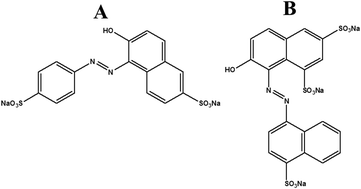Binding and inhibitory effect of the food colorants Sunset Yellow and Ponceau 4R on amyloid fibrillation of lysozyme†
Abstract
Amyloid fibrillogenesis of proteins is known to be the root cause of a large number of diseases like Parkinson's, Alzheimer's, and Huntington's disease, spongiform encephalopathy, amyloid polyneuropathy, type-II diabetes, etc. In the present work, the impact of Sunset Yellow (SY) and Ponceau 4R (P4R) food colorants on amyloid fibrillation of lysozyme (Lyz) under acidic pH and high temperature was studied using Thioflavin T (ThT) fluorescence, Congo Red (CR) assay, circular dichroism (CD) spectroscopy, transmission electron microscopy (TEM) and field emission scanning electron microscopy (FESEM). The results illustrated that SY and P4R inhibited the formation of amyloid fibrils. In addition, the binding between food colorants (SY and P4R) and Lyz was investigated using various spectroscopic methods such as fluorescence, absorption and CD spectroscopy along with theoretical approaches (such as docking and simulation). The binding results suggested that P4R has a remarkably higher binding affinity for Lyz in comparison to SY. In summary, we hope the in vitro fibrillation and interaction studies in the presence of food colorants (SY and P4R) are helpful to gain a better understanding about the mechanism of amyloid fibril formation and interaction at the molecular level.



 Please wait while we load your content...
Please wait while we load your content...